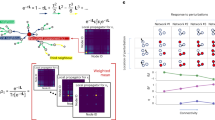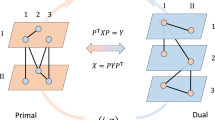Abstract
Our world is linked by a complex mesh of networks through which information, people and goods flow. These networks are interdependent on each other, and present structural and dynamical features1,2,3,4,5,6 different from those observed in isolated networks7,8,9. Although examples of such dissimilar properties are becoming more abundant—such as in diffusion, robustness and competition—it is not yet clear where these differences are rooted. Here we show that the process of building independent networks into an interconnected network of networks undergoes a structurally sharp transition as the interconnections are formed. Depending on the relative importance of inter- and intra- layer connections, we find that the entire interdependent system can be tuned between two regimes: in one regime, the various layers are structurally decoupled and they act as independent entities; in the other regime, network layers are indistinguishable and the whole system behaves as a single-level network. We analytically show that the transition between the two regimes is discontinuous even for finite-size networks. Thus, any real-world interconnected system is potentially at risk of abrupt changes in its structure, which may manifest new dynamical properties.
This is a preview of subscription content, access via your institution
Access options
Subscribe to this journal
Receive 12 print issues and online access
$259.00 per year
only $21.58 per issue
Buy this article
- Purchase on SpringerLink
- Instant access to full article PDF
Prices may be subject to local taxes which are calculated during checkout


Similar content being viewed by others
References
Buldyrev, S. V. et al. Catastrophic cascade of failures in interdependent networks. Nature 464, 1025–1028 (2010).
Gao, J., Buldyrev, S. V., Stanley, H. E. & Havlin, S. Networks formed from interdependent networks. Nature Phys. 8, 40–48 (2012).
Son, S-W. et al. Percolation theory on interdependent networks based on epidemic spreading. Euro Phys Lett. 97, 16006 (2012).
Saumell-Mendiola, A., Serrano, M. Á. & Boguñá, M. Epidemic spreading on interconnected networks. Phys. Rev. E 86, 026106 (2012).
Gómez, S. et al. Diffusion dynamics on multiplex networks. Phys. Rev. Lett. 110, 028701 (2013).
Aguirre, J., Papo, D. & Buldú, J. M. Successful strategies for competing networks. Nature Phys. 9, 230–234 (2013).
Albert, R. & Barabási, A-L. Statistical mechanics of complex networks. Rev. Mod. Phys. 74, 47–97 (2002).
Newman, M. E. J. Networks: An Introduction (Oxford Univ. Press, 2010).
Dorogovtsev, S. N., Goltsev, A. V. & Mendes, J. F. F. Critical phenomena in complex networks. Rev. Mod. Phys. 80, 1275–1335 (2008).
Szella, M., Lambiotte, R. & Thurner, S. Multirelational organization of large-scale social networks in an online world. Proc. Natl Acad. Sci. USA 107, 13636–13641 (2010).
Barthélemy, M. Spatial networks. Phys. Rep. 499, 1–101 (2011).
Albert, R., Jeong, H. & Barabási, A-L. Error and attack tolerance of complex networks. Nature 406, 378–382 (2000).
Merris, R. Laplacian matrices of graphs: a survey. Linear Algebra Appl. 197–198, 143–176 (1994).
Chung, F., Lu, L. & Vu, V. Spectra of random graphs with given expected degrees. Proc. Natl Acad. Sci. USA 100, 6313–6318 (2003).
Chung, F. Spectral Graph Theory (CBMS Regional Conference Series in Mathematics, American Mathematical Society, 1997).
Biyikoglu, T., Leydold, J. & Stadler, P. F. Laplacian Eigenvectors of Graphs: Perron–Frobenius and Faber–Krahn Type Theorems (Lecture Notes in Mathematics, Springer, 2007).
Fielder, M. Algebraic connectivity of Graphs. Czech. Math. J. 23, 298–305 (1973).
Fielder, M. A property of eigenvectors of nonnegative symmetric matrices and its application to graph theory. Czech. Math. J. 25, 619–633 (1975).
Fielder, M. Laplacian of graphs and algebraic connectivity. Comb. Graph Theory 25, 57–70 (1989).
Mohar, B. Graph Theory, Combinatorics, and Applications 871–898 (Wiley, 1991).
Ng, A. Y., Jordan, M. I. & Weiss, Y. Advances in Neural Information Processing Systems Vol. 14 (MIT Press, 2001).
Courant, R. Über die Eigenwerte bei den Differentialgleichungen der mathematischen Physik. Math. Z. 7, 1–57 (1920).
Fischer, E. Über quadratische Formen mit reellen Koeffizienten. Mon. Math. Phys. 16, 234–249 (1905).
Kolmogorov, V. & Zabih, R. What energy functions can be minimized via graph cuts. IEEE Trans. Pattern Anal. 26, 65–81 (2004).
Reidys, C. M. & Stadler, P. F. Combinatorial landscapes. SIAM Rev. 44, 3–54 (2002).
Mézard, M., Parisi, G. & Virasoro, M. A. Spin Glass Theory and Beyond (World Scientific, 1987).
Grover, L. K. Local search and the local structure of NP-complete problems. Oper. Res. Lett. 12, 235–243 (1992).
Blundell, S. J. & Blundell, K. M. Concepts in Thermal Physics (Oxford Univ. Press, 2008).
Jamakovic, A. & Van Mieghem, P. in Proc. 7th Int. IFIP-TC6 Networking Conf. on AdHoc and Sensor Networks, Wireless Networks, Next Generation Internet 183–194 (Springer, 2008).
Parshani, R., Buldyrev, S. V. & Havlin, S. Interdependent networks: Reducing the coupling strength leads to a change from a first to second order percolation transition. Phys. Rev. Lett. 105, 048701 (2010).
Acknowledgements
This work has been partially supported by the Spanish DGICYT Grants FIS2012-38266, FET projects PLEXMATH (318132) and the Generalitat de Catalunya 2009-SGR-838. F.R. acknowledges support from the Spanish Ministerio de Ciencia e Innovacion through the Ramón y Cajal programme. A.A. acknowledges the ICREA Academia and the James S. McDonnell Foundation.
Author information
Authors and Affiliations
Contributions
F.R and A.A. designed and performed the research, and wrote the paper.
Corresponding author
Ethics declarations
Competing interests
The authors declare no competing financial interests.
Supplementary information
Supplementary Information
Supplementary Information (PDF 463 kb)
Rights and permissions
About this article
Cite this article
Radicchi, F., Arenas, A. Abrupt transition in the structural formation of interconnected networks. Nature Phys 9, 717–720 (2013). https://doi.org/10.1038/nphys2761
Received:
Accepted:
Published:
Issue Date:
DOI: https://doi.org/10.1038/nphys2761



